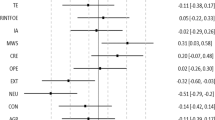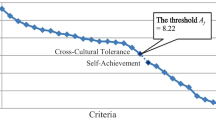Abstract
Purpose
Identifying the characteristics of chief executive officers (CEOs) has been a longstanding goal in leadership and individual differences research. The purpose of this exploratory study was to consider which individual difference and career path variables differentiate CEOs from other senior managers.
Design/Methodology/Approach
Participants (N = 1152) were UK-based senior managers (n = 1040) and CEOs (n = 112) who completed a self-report measure of the Five Factor Model of personality (NEO-PI-R), a measure of cognitive ability (graduate and management aptitude test), and answered a number of additional questions on their career paths as part of development centres. Analyses comprised inter-individual mean difference tests, intra-individual external profile analysis and logistic regression.
Findings
Results indicated that personality facets of impulsiveness, vulnerability, activity and dutifulness showed the largest mean differences. No significant effects were found for the criterion profile pattern, but significant effects were found for profile level. Of the additional predictors, career path variables were the strongest predictors of CEO status.
Implications
The combination of significant effects across domains of individual differences and career path variables emphasizes the importance of a multivariate approach in the study of leadership, top management teams and career progression.
Originality/Value
The current study combines personality, cognitive ability, demographic and career path variables, and applies intra-individual methodologies to explore the characteristics of the very top level of organisational hierarchy.

Similar content being viewed by others
References
Akaike, H. (1976). An information criterion (AIC). Math Sci, 14, 5–9.
Barrick, M. R., Mount, M. K., & Judge, T. A. (2001). Personality and performance at the beginning of the new millennium: What do we know and where do we go next? Personality and Performance, 9, 9–30.
Beckstead, J. W. (2012). Isolating and examining sources of suppression and multicollinearity in multiple linear regression. Multivariate Behavioral Research, 47, 224–246.
Bertrand, M. (2009). CEOs. Annual Review of Economics, 1, 121–150.
Blinkhorn, S. (1985). Graduate and managerial assessment manual and user guide. Dorchester: Dorset Press.
Bono, J. E., Shen, W., & Yoon, D. J. (2014). Personality and leadership: Looking back, looking ahead. In D. Day (Ed.), The Oxford handbook of leadership and organizations. Oxford: Oxford University Press.
Boudreau, J. W., Boswell, W. R., & Judge, T. A. (2001). Effects of personality on career success in the United States and Europe. Journal of Vocational Behavior, 58, 53–81.
Bulut, O., & Desjardins, C. D. (2013). profileR: Profile analysis of multivariate data in R. R package version 0.2-1. http://CRAN.R-project.org/package=profileR. Accessed 13 July 2015.
Cannella, A. A., Park, J. H., & Lee, H. U. (2008). Top management team functional background diversity and firm performance: Examining the roles of team member colocation and environmental uncertainty. Academy of Management Journal, 51, 768–784.
Caspi, A., Roberts, B. W., & Shiner, R. L. (2005). Personality development: Stability and change. Annual Review of Psychology, 56, 453–484.
Cohen, J., Cohen, P., West, S. G., & Aiken, L. S. (2003). Applied multiple regression/correlation analysis for the behavioral sciences (3rd ed.). Mahwah, NJ: Lawrence Erlbaum Associates.
Colbert, A. E., Barrick, M. R., & Bradley, B. H. (2014). Personality and leadership composition in top management teams: Implications for organizational effectiveness. Personnel Psychology, 67, 351–387.
Costa, P. T., & McCrae, P. R. (1992). Revised NEO-personality inventory (NEO-PI-R) and NEO five factor inventory (NEO-FFI): Professional manual. Odessa, FL: Psychological Assessment Resources.
Crossland, C., Zyung, J., Hiller, N., & Hambrick, D. (2013). CEO career variety: Effects on firm-level strategic and social novelty. Academy of Management Journal, 57, 652–674.
Culpepper, S. A. (2008). Conducting external profile analysis with multiple regression. Practical Assessment, Research & Evaluation, 13(1). Retrieved from http://pareonline.net/pdf/v13n1.pdf.
Daily, C. M., Certo, S. T., & Dalton, D. R. (2000). International experience in the executive suite: The path to prosperity? Strategic Management Journal, 21, 515–523.
Davison, M. L., Chang, Y.-F., & Davenport, E. C, Jr. (2014). Modeling configural patterns in latent variable profiles: Association with an endogenous variable. Structural Equation Modeling: A Multidisciplinary Journal, 21, 81–93.
Davison, M. L., & Davenport, E. C, Jr. (2002). Identifying criterion-related patterns of predictor scores using multiple regression. Psychological Methods. Psychological Methods, 7, 468–484.
Desjardins, C. D. (2012). profanal: Implements profile analysis described in Davison & Davenport (2002). R package version 1.0. http://CRAN.R-project.org/package=profanal. Accessed 13 July 2015.
Dilchert, S. (2007). Peaks and valleys: Predicting interests in leadership and managerial positions from personality profiles. International Journal of Selection and Assessment, 15, 317–334.
Finkelstein, S., & Hambrick, D. C. (1990). Top-management-team tenure and organizational outcomes: The moderating role of managerial discretion. Administrative Science Quarterly, 35, 484–503.
Giberson, T. R., Resick, C. J., & Dickson, M. W. (2005). Embedding leader characteristics: An examination of homogeneity of personality and values in organizations. Journal of Applied Psychology, 90, 1002–1010.
Hambrick, D. C. (2007). Upper echelons theory: An update. Academy of Management Review, 32, 334–343.
Hambrick, D. C., & Mason, P. A. (1984). Upper echelons: The organization as a reflection of its top managers. Academy of Management Review, 9, 193–206.
Harrell, F. E. (2012). rms: Regression modeling strategies. R package version 3.6-2. http://CRAN.R-project.org/package=rms. Accessed 13 July 2015.
Hoffman, B. J., Woehr, D. J., Maldagen-Youngjohn, R., & Lyons, B. D. (2011). Great man or great myth? A quantitative review of the relationship between individual differences and leader effectiveness. Journal of Occupational and Organizational Psychology, 84, 347–381.
Hogan, J., & Holland, B. (2003). Using theory to evaluate personality and job-performance relations: A socioanalytic perspective. Journal of Applied Psychology, 88, 100–112.
Hogan, R., & Judge, T. (2013). Personality and leadership. In M. G. Rumsey (Ed.), The Oxford handbook of leadership (p. 37). New York: Oxford University Press.
Hough, L. M., & Oswald, F. L. (2008). Personality testing and industrial–organizational psychology: Reflections, progress, and prospects. Industrial and Organizational Psychology, 1, 272–290.
Judge, T. A., Ilies, R., & Colbert, A. E. (2004). Intelligence and leadership: A quantitative review and test of theoretical propositions. Journal of Applied Psychology, 89, 542–552.
Judge, T. A., Klinger, R. L., & Simon, L. S. (2010). Time is on my side: Time, general mental ability, human capital, and extrinsic career success. Journal of Applied Psychology, 95, 92–107.
Judge, T. A., Rodell, J. B., Klinger, R. L., Simon, L. S., & Crawford, E. R. (2013). Hierarchical representations of the five-factor model of personality in predicting job performance: Integrating three organizing frameworks with two theoretical perspectives. Journal of Applied Psychology, 98, 875–925.
Kaplan, S. N., Klebanov, M. M., & Sorensen, M. (2012). Which CEO characteristics and abilities matter? The Journal of Finance, 67, 973–1007.
Keselman, H. J., Miller, C. W., & Holland, B. (2011). Many tests of significance: New methods for controlling Type I error. Psychological Methods, 16, 420–431.
Le, K., Donnellan, M. B., & Conger, R. (2014). Personality development at work: Workplace conditions, personality changes, and the corresponsive principle. Journal of Personality, 82, 44–56.
Major, J. T., Johnson, W., & Bouchard, T. J. (2011). The dependability of the general factor of intelligence: Why small, single-factor models do not adequately represent g. Intelligence, 39, 418–433.
Marsh, H. W., Lüdtke, O., Muthén, B., Asparouhov, T., Morin, A. J. S., Trautwein, U., & Nagengast, B. (2010). A new look at the big-five factor structure through exploratory structural equation modeling. Psychological Assessment, 22, 471–491.
Moutafi, J., Furnham, A., & Crump, J. (2007). Is managerial level related to personality? British Journal of Management, 18, 272–280.
Nagelkerke, N. J. D. (1991). A note on a general definition of the coefficient of determination. Biometrika, 78, 691–692.
Nielsen, S. (2010). Top management team diversity: A review of theories and methodologies. International Journal of Management Reviews, 12, 301–316.
Ones, D. S., & Dilchert, S. (2009). How special are executives? How special should executive selection be? Observations and recommendations. Industrial and Organizational Psychology, 2, 163–170.
Palaiou, K., & Furnham, A. (2014). Are bosses unique? Personality facet differences between CEOs and staff in five work sectors. Consulting Psychology Journal: Practice and Research, 66, 173–196.
Peterson, R. S., Smith, D. B., Martorana, P. V., & Owens, P. D. (2003). The impact of chief executive officer personality on top management team dynamics: One mechanism by which leadership affects organizational performance. Journal of Applied Psychology, 88, 795–808.
Priem, R. L., Lyon, D. W., & Dess, G. (1999). Inherent limitations of demographic proxies in top management heterogeneity research. Journal of Management, 25, 935–953.
Romano, J. P., & Shaikh, A. M. (2006). Step-up procedures for control of generalizations of the familywise error rate. Annals of Statistics, 34, 1850–1873.
Schmidt, F. L., & Hunter, J. E. (2000). Select on intelligence. In E. A. Locke (Ed.), Handbook of principles of organizational behavior (pp. 3–14). Oxford: Blackwell.
Silzer, R., & Jeanneret, R. (2011). Individual psychological assessment: A practice and science in search of common ground. Industrial and Organizational Psychology, 4, 270–296.
Spector, P. E., Rogelberg, S. G., Ryan, A. M., Schmitt, N., & Zedeck, S. (2014). Moving the pendulum back to the middle: Reflections on an introduction to the inductive research special issue of the Journal of Business and Psychology. Journal of Business and Psychology, 29, 499–502.
Winsborough, D. L., & Sambath, V. (2013). Not like us: An investigation into the personalities of New Zealand CEOs. Consulting Psychology Journal: Practice and Research, 65, 87–107.
Zaccaro, S. J. (2012). Individual differences and leadership: Contributions to a third tipping point. The Leadership Quarterly, 23, 718–728.
Acknowledgments
The authors would like to thank Prof. Mark Davison (Department of Educational Psychology, University of Minnesota) for comments on an early draft of this manuscript, and John Crump from Kaisen Consulting for access to the data.
Author information
Authors and Affiliations
Corresponding author
Rights and permissions
About this article
Cite this article
Booth, T., Murray, A.L., Overduin, M. et al. Distinguishing CEOs from Top Level Management: A Profile Analysis of Individual Differences, Career Paths and Demographics. J Bus Psychol 31, 205–216 (2016). https://doi.org/10.1007/s10869-015-9416-7
Published:
Issue Date:
DOI: https://doi.org/10.1007/s10869-015-9416-7




